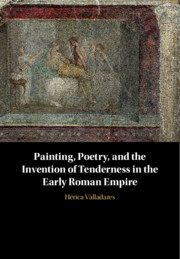Book contents
- Painting, Poetry, and the Invention of Tenderness in the Early Roman Empire
- Painting, Poetry, and the Invention of Tenderness in the Early Roman Empire
- Copyright page
- Dedication
- Contents
- List of Plates
- List of Figures
- List of Tables
- Acknowledgments
- Introduction On Roman Tenderness
- One The Tenderness of Lovers
- Two The Tenderness of Monsters
- Three The Tender Interior
- Epilogue Tenderness Transformed
- Notes
- Bibliography
- Index
Two - The Tenderness of Monsters
Published online by Cambridge University Press: 26 November 2020
- Painting, Poetry, and the Invention of Tenderness in the Early Roman Empire
- Painting, Poetry, and the Invention of Tenderness in the Early Roman Empire
- Copyright page
- Dedication
- Contents
- List of Plates
- List of Figures
- List of Tables
- Acknowledgments
- Introduction On Roman Tenderness
- One The Tenderness of Lovers
- Two The Tenderness of Monsters
- Three The Tender Interior
- Epilogue Tenderness Transformed
- Notes
- Bibliography
- Index
Summary
This chapter addresses the more common subject of mythological representations, focusing on one of the most frequently depicted mythological lovers in Roman wall painting, the cyclops Polyphemus. Beginning with the earliest extant Roman depiction of Polyphemus as a lover, a now much damaged fresco in the so-called House of Livia on the Palatine (30s BCE), the analysis proceeds by exploring the creation of a tender iconography for this well-known monster over the course of the first century CE. At the same time, it considers different literary treatments of this myth by Theocritus, Virgil, and Ovid. These poetic and pictorial portrayals of Polyphemus as a long-suffering, sympathetic romantic protagonist likewise point to the emergence of a Roman aesthetic of tenderness, capable of transforming even the most savage of Homeric characters into a pitiable, domesticated creature. This study of Polyphemus as a lover in Roman poetry and painting also traces the reception of the Roman aesthetic of tenderness among non-elite contexts on the Bay of Naples. A well-known Campanian image of Polyphemus receiving a love letter points to the influence of Latin elegy in the representation of this well-known mythical character in Roman art.
Keywords
- Type
- Chapter
- Information
- Publisher: Cambridge University PressPrint publication year: 2020



